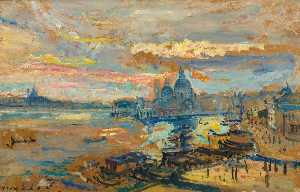Arbit Blatas
Arbit Blatas
Born: 1908
Death: 1999
Biography:
Arbit Blatas on 19 November 1908, Arbit Blatas was a precocious talent who began exhibiting in his native country at the age of 15. He left for Paris and, at the age of 21, became the youngest member of the School of Paris. When Blatas was 24, the Galerie Nationale du Jeu de Paume in Paris first acquired some of his paintings; he had already become a colleague and friend of many of the great figures of the Paris art world, such as Vlaminck, Soutine, Picasso, Utrillo, Braque, Zadkine, Léger and Derain. He was to paint and sculpt them all, as well as Bonnard, Vuillard, Matisse, Dufy, Van Dongen, Cocteau, Marquet and many others. His 30 portraits in oil and bronzes are considered a unique document of the painters and sculptors of that dynamic period in 20th-century French painting..
In the 1930s, Blatas exhibited in London and New York, as well as in his adoptive home of Paris. Fleeing Nazi-occupied Europe in 1941 for the United States, Blatas became an American citizen. After the war, Blatas divided his life between New York and France; in 1947, he was elected a life member of the Salon d'Automne, in the latter country. His life-size bronze of his colleague and friend Chaim Soutine, created in 1967, was highly admired by André Malraux. In 1987, the City of Paris installed the statue in Montparnasse and conferred on Blatas the Médaille de Vermeil. A life-size statue of another close friend and colleague, Jacques Lipchitz, now stands in the garden of the Hotel de Ville. In 1978, Arbit Blatas was named Chevalier de la Légion d'Honneur by the French Government for his contribution to French art as an outstanding member of the School of Paris, and in 1994 was promoted to the rank of Officier de la Légion d'Honneur.
In the late 1970s, the Holocaust – a theme that had hitherto lain dormant for the artist – burst forth in Blatas' work and remained a major theme for the rest of his life. His personal connection to the Holocaust was profound—his parents were deported from Lithuania in 1941 and his mother died in the Stutthof concentration camp while his father managed to survive the Dachau concentration camp. After the war, Blatas returned to France to bring his father back with him to the United States.
Blatas memorialized the Holocaust in many major works. His drawings appeared in the 1978 American television series Holocaust and formed the basis for four public memorials, consisting of seven powerful bas-reliefs, known as The Monument of the Holocaust, on permanent display in four countries: Italy France, the United States and Lithuania. In Italy, in the ghetto di Venezia in Venice are located two big bas-reliefs: one in memory of the Shoah in general, and the second one dedicated to the Venetian Jews who were deported between 1943 and 1944. 246 names written on a wooden wall behind a bas relief with a train. Both the monument were made in the '90.
The first edition of this monument was installed in the historic Venetian Ghetto on April 25, 1980, on the occasion of Liberazione, the national holiday celebrating liberation from Benito Mussolini's government. On that occasion, then-Mayor Mario Rigo decorated Blatas with the Venezia Riconoscente. On September 19, 1993, in the same Ghetto, then-President of Italy Oscar Scalfaro honoured Blatas by dedicating his sculpture The Last Train, a monument honouring the 50th anniversary of the deportation of the Jews from the Venetian Ghetto. The distinguished Italian art historian Enzo di Martini wrote of Blatas' Monument of the Holocaust: "In complete contrast to his paintings, these bronzes are hammered and chiselled in anger and tragedy."
The second edition of The Monument of the Holocaust was dedicated at the Mémorial du Martyr Juif Inconnu in Paris on April 23, 1981. The third edition was placed at One Dag Hammarskjold Plaza on April 25, 1982 by the Anti-Defamation League, across from the United Nations in New York. In 2009, this edition was installed permanently at the Hebrew Union College-Jewish Institute of Religion in New York City. In 2003, the fourth and final edition of this series of sculptures was donated posthumously by his widow as part of the consecration of the memorial at the Ninth Fort in Blatas' native Kaunas, Lithuania, the location from which Blatas' parents were deported in 1941.
Two other major subjects became leitmotifs in Blatas' work: his great friend Marcel Marceau and "The Threepenny Opera". Both inspired the artist in paintings, sculpture, and lithography. Marceau's portraits range from large portraits to small-scale studies, to sculptures, to sets of lithographs that capture the mime in mid-air. Blatas attended the world première of "The Threepenny Opera" in Berlin in 1928; the musical theatre work by Kurt Weill and Berthold Brecht inspired Blatas for the next 70 years. His canon of work depicting scenes and characters from "The Threepenny Opera" includes 18 portraits, 10 sculptures, several large canvases and sets of color and black-and-white lithographs. The preface by Lotte Lenya, Weill's widow, (published in 'The Art of an Opera' (NYC) June 1962) to the first edition of Threepenny lithographs, pays tribute to Blatas' understanding of the work:
More...
Wikipedia link: Click Here


